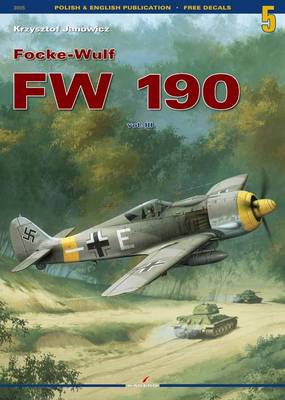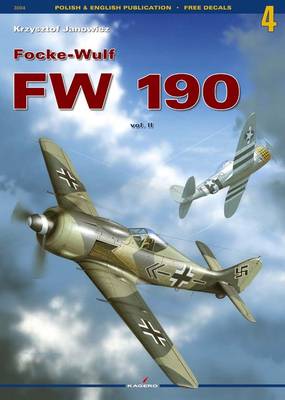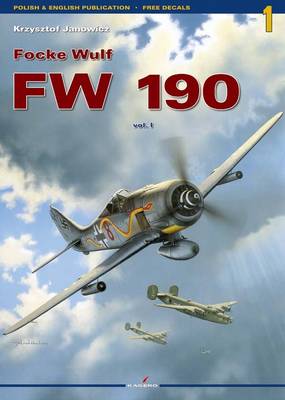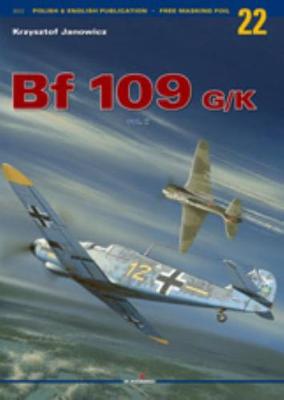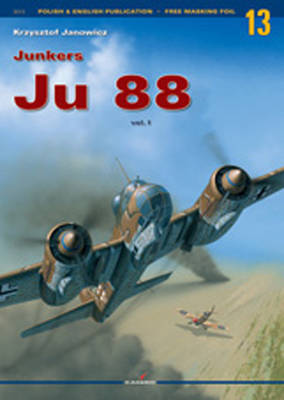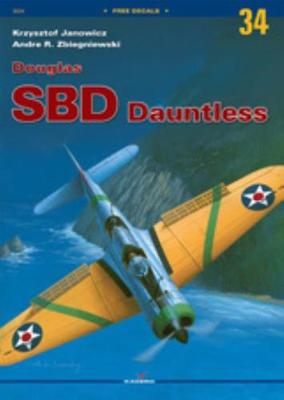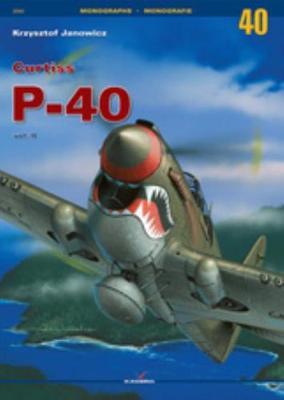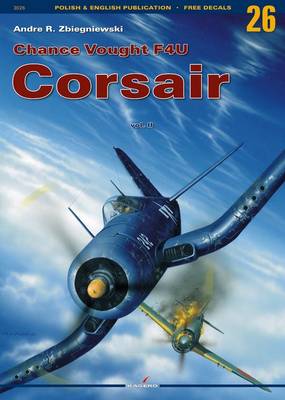Monographs
9 total works
Complete with 124 pages, 167 photographs (including 22 in colour), 10 sheets of technical drawings in 1:48 scale, 7 colour charts with 16 examples of camouflage schemes.
Free 1:32, 1:48 and 1:72 decals for 8 schemes:
Fw 190 F-8,`Green Double Chevron’ of Stab II Gruppe of SG 77 or SG 3, Germany, May 1945.
Fw 190 F-8,`White T’ of II./SG 77, Lemberg (Ukraine), Summer 1944.
Fw 190 F-8,`White 4’ of 7./SG 10, Ceske Budejowice (Czechoslovakia), May 1945.
Fw 190 F-8 of Stab III./SG 10, Czechoslovakia, Spring 1945.
Fw 190 F-8, W.Nr. 584 205,`Black M’ of III./SG 3, Sweden, May 1945.
Fw 190 F-9/Panzerblitz,`White 2’ of 7./SG 77, Chrudim (Czechoslovakia), Spring 1945.
Fw 190 F-9,`Black 9’ of II./SG 2, Varpalotta (Hungary), Spring 1945.
Fw 190 F-9, W.Nr. 440 382,`Yellow 10’ of NSGr 20 or III./KG 200, Wunsdorf (Germany), Spring 1945.
About the Series
Monographs focuses on an individual type of aircraft. Each monograph contains descriptions of the aircraft’s origin, its variants and combat history. Each volume includes several hundred archive photographs, technical scale drawings and colour profile artwork. Each book also has free extras for modellers, with decals and masking foil.
128 pages, 171 photographs (many previously unpublished), 8 sheets of factory drawings with detailed view of the construction and armament, 11 colour charts with 24 examples of camouflage schemes.
Free 1:32, 1:48 and 1:72 decals for 7 schemes:
Fw 190 A-8,`Black 11’, flown by Lt. Günther Heym of Stab/JG 51, Zichenau (Poland), Summer/Autumn 1944.
Fw 190 A-2, W.Nr. 20206,`Black Chevron’, flown by Fw. Walter Grünlinger of Stab III./JG 26, France, 1942.
Fw 190 A-5,`White 8’ of IV./JG 51, Eastern Front, Summer 1943.
Fw 190 A-8,`White 16’ of 13./JG 54, France, Summer 1944.
Fw 190 A-8,`Black 9’ of II./JG 301, Germany, Spring 1945.
Fw 190 A-5, W.Nr. 2700,`Black 8’ of 2./JG 11, Husum (Germany), Summer 1943.
Fw 190 A-8/R2,`White 14’, flown by Uffz. Oskar Bösch of Sturmstaffel 1, Salzwedel (Germany), February 1944.
About the Series
Monographs focuses on an individual type of aircraft. Each monograph contains descriptions of the aircraft’s origin, its variants and combat history. Each volume includes several hundred archive photographs, technical scale drawings and colour profile artwork. Each book also has free extras for modellers, with decals and masking foil.
96 pages, 91 photos, 24 sheets of 1:48 and 1:72 scale drawings with specification of external changes on production-run versions of the aircrat, 11 pages of colour illustrations with 28 examples of camouflage schemes.
Free 1:48 and 1:72 decals for 4 schemes:
Fw 190 A-4, W.Nr. 7328,`Yellow 10’ of 6./JG 1, Woernsdredcht (Netherlands), April 1943.
Fw 190 A-7/R6,`Red 8’, flown by Fw. Hartkopf of JGr 10, Parchim (Germany), Summer 1944.
Fw 190 A-8/R2,`Yellow 17’, flown by Uffz. Willi Unger of 12./JG 3, Barth (Germany), May 1944.
Fw 190 A-8,`Red 11’ of JGr 10, Parchim (Germany), Autumn 1944.
About the Series
Monographs focuses on an individual type of aircraft. Each monograph contains descriptions of the aircraft’s origin, its variants and combat history. Each volume includes several hundred archive photographs, technical scale drawings and colour profile artwork. Each book also has free extras for modellers, with decals and masking foil.
One of the first true modern fighters of the era, including such features as an all-metal monocoque construction, a closed canopy, and retractable landing gear, the Bf 109 was still in service at the dawn of the jet age at the end of World War II, during which it was the backbone of the German Luftwaffe fighter force.
Originally conceived as an interceptor, later models were developed to fulfill multiple tasks, serving as bomber escort, fighter bomber, day-, night- all-weather fighter, bomber destroyer, ground-attack aircraft, and as reconnaissance aircraft. Through constant development, it remained competitive with the latest Allied fighter aircraft until the end of the war.
Content covers: The Ostfront; Operations in Africa; Eastern Front 1943; In the defence of the Reich and Beyond the Polar Circle.
About the Series
Monographs focuses on an individual type of aircraft. Each monograph contains descriptions of the aircraft’s origin, its variants and combat history. Each volume includes several hundred archive photographs, technical scale drawings and colour profile artwork. Each book also has free extras for modellers, with decals and masking foil.
Originally designed as a bomber plane, Ju 88 was used as a torpedo, reconnaissance and ground attack aircraft as well as a long-range fighter. The book features a detailed description of the plane’s structure, technical data and a chapter about camouflage and markings.
Complete with 116 pages, 153 photographs, 28 sheets of technical drawings in 1:48 and 1:72 scale with specification of external changes in production-run versions of the aircraft and 5 colour charts with 8 examples of camouflage schemes.
Free 1:48 and 1:72 decals for 3 schemes:
Ju 88 A-4,`B3+AM’ of 4./KG 54, Sicily, Spring 1943.
Ju 88 A-5,`4D+VH’ of 1./KG 30, the Balkans, April 1941.
Ju 88 A-5,`F’ of I./KG 51, France, Spring 1941.
About the Series
Monographs is a series focusing on an individual type of aircraft. Each monograph contains descriptions of the aircraft’s origins, its variants and combat history. Each volume includes several hundred archive photographs, technical scale drawings and colour profile artworks, with free extras for modellers, including decals and masking foil.
The P-40 design was a modification of the previous Curtiss P-36; this reduced development time and enabled a rapid entry into production and operational service.
The P-40's lack of a two-stage supercharger made it inferior to Luftwaffe fighters such as the Messerschmitt Bf 109 or the Focke-Wulf Fw 190 in high altitude combat and it was rarely used in operations in Northwest Europe. Between 1941 and 1944, however, the P-40 played a critical role with Allied air forces in three major theaters: North Africa, the Southwest Pacific and China. It also had a significant role in the Middle East, Southeast Asia, Eastern Europe, Alaska and Italy.
About the series
Monographs is a series focusing on an individual type of aircraft. Each monograph contains descriptions of the aircraft’s origins, its variants and combat history. Each volume includes several hundred archive photographs, technical scale drawings and colour profile artworks, with free extras for modellers, including decals and masking foil.
The book covers the early battles of the U.S. Navy units against the IJNAF: the attack on Pearl Harbor, the Battle of the Coral Sea, the Battle of Midway and the Guadalcanal campaign. The author constitutes a thorough insight into the decisive impact on air warfare in PTO made by units operating Dauntless during the early stage of war, when the aircraft gained its reputation as the`Slow but deadly’.
The actions of USMC units equipped with Dauntless are also described. The monograph features specifications of the key Dauntless variants and lists of serial numbers and units operating Dauntless.
About the Series
Monographs focuses on an individual type of aircraft. Each monograph contains descriptions of the aircraft’s origin, its variants and combat history. Each volume includes several hundred archive photographs, technical scale drawings and colour profile artwork. Each book also has free extras for modellers, with decals and masking foil.
Starting with the actions of legendary`Flying Tigers’ over China and Burma, the author discusses the battles over Malaya, the Philippines, Australia, the Solomon Islands and Rabaul together with the defence of the Aleutian Islands, the comeback to China and the breakthrough in New Guinea, featuring the operations of the RAAF and the RNZAF units equipped with P-40s. A list of pilots with 5 or more victories in the Pacific and CBI is also included.
Complete with 100 pages, 117 photographs, 24 sheets of technical drawings in 1:48 and 1:72 scale with specification of external changes in production-run versions of the aircraft, 9 colour charts with 11 examples of camouflage schemes.
About the Series
Monographs focuses on an individual type of aircraft. Each monograph contains descriptions of the aircraft’s origin, its variants and combat history. Each volume includes several hundred archive photographs, technical scale drawings and colour profile artwork. Each book also has free extras for modellers, with decals and masking foil.
The subsequent chapters are devoted to French use of Corsairs in Indochina and F4U’s service in the Honduran and Salvadoran air forces during the Soccer War in 1969. The book includes technical data, lists of F4U squadrons as of September 1945, USMC& USN Corsair aces and many more.
Free 1:48 and 1:72 decals for 7 schemes:
F4U-1D, flown by 2/Lt. Marvin S. Bristow of VMF-224, Okinawa, May 1945.
F4U-4 (BuNo 80715) of VF-82, USS Randolph (CV-15), 1946.
F4U-5N (BuNo 124715), flown by Cpt. Fernando Soto Henriquez of the FAH, Honduras, Summer 1969.
F4U-7 (BuNo 133657) of Flotille 14F Aeronavale, Cuers, France, October 1963.
FG-1D (BuNo 88242), flown by Lt. Joseph P. Lynch of VMF-224, Okinawa, July 1945.
Corsair Mk.II, flown by Lt. Cole of No. 1830 Sqn FAA, HMS Illustrious, April 1945.
Corsair Mk.IV (KD748) of No. 1853 Sqn FAA, HMS Venerable, 1945.
About the Series
Monographs focuses on an individual type of aircraft. Each monograph contains descriptions of the aircraft’s origin, its variants and combat history. Each volume includes several hundred archive photographs, technical scale drawings and colour profile artwork. Each book also has free extras for modellers, with decals and masking foil.
